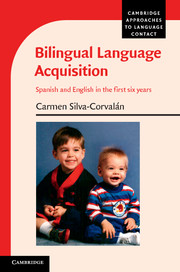Book contents
- Frontmatter
- Dedication
- Contents
- List of figures
- List of tables
- Series editor’s foreword
- Preface
- Acknowledgments
- List of abbreviations
- 1 Introduction
- 2 Methodology
- 3 Bilingual development
- 4 Subjects in English and Spanish
- 5 The order of constituents: subject position in English and Spanish
- 6 The acquisition of ser, estar, and be
- 7 The development of verb morphology
- 8 Discussion and conclusions
- Appendix 1 Transcription instructions
- Appendix 2 Calculation of MLUw
- Appendix 3 Spanish adjectives used with copulas up to age 6;0
- Appendix 4 The siblings’ early verb lexicon in English and Spanish
- Appendix 5 Excerpt from an adapted Goldilocks story
- References
- Index of authors
- General index
3 - Bilingual development
a linguistic profile of the first six years
Published online by Cambridge University Press: 18 December 2014
- Frontmatter
- Dedication
- Contents
- List of figures
- List of tables
- Series editor’s foreword
- Preface
- Acknowledgments
- List of abbreviations
- 1 Introduction
- 2 Methodology
- 3 Bilingual development
- 4 Subjects in English and Spanish
- 5 The order of constituents: subject position in English and Spanish
- 6 The acquisition of ser, estar, and be
- 7 The development of verb morphology
- 8 Discussion and conclusions
- Appendix 1 Transcription instructions
- Appendix 2 Calculation of MLUw
- Appendix 3 Spanish adjectives used with copulas up to age 6;0
- Appendix 4 The siblings’ early verb lexicon in English and Spanish
- Appendix 5 Excerpt from an adapted Goldilocks story
- References
- Index of authors
- General index
Summary
Introduction
How do Nico and Brennan develop productive bilingual competence in their first six years of life? This is a wide-ranging question that this and subsequent chapters address only to some extent; it would take volumes to fully approach the task as it deserves. Indeed, attaining bilingual competence involves the development of knowledge of not only two different semantic, phonological, morphological, and syntactic systems, but also, importantly, of how to situate these systems relative to each other and realize each of them in meaningful acts of communication that suit the social conventions of monolingual and bilingual environments. This chapter presents an overview of how, in the span of a few years, the siblings became competent speakers of two languages, albeit to different degrees. Indeed, the aim of the book is to identify and account for the similarities and differences between the two developing bilingual siblings, who differ in the amount of use of and exposure to English and Spanish.
From words to sentences:
BFLA children do not differ from monolingual children with respect to stages of ontogenetic language development: they move on from babbling to single words, to word combinations, to sentences, and, many of them, to fluent conversations in each of their languages. Babbling occurs during the first year of life and lays the foundation for the development of speech. Although there is interindividual variation, it is generally the case that, by the end of the first year, BFLA children understand words and simple sentences in their two languages. Nico and Brennan fit this pattern of development. Diary records for Nico at age 0;11.21 and for Brennan at age 1;0.22 note that they understood simple questions and requests in both languages (e.g., Where is X? and ¿Dónde está X? [they look or point in the direction of X], Give me X and Dame X [they hand in X], No [noʊ] and [no] [they stop X-ing]). By age 3;0, they held conversations in both languages and were able to produce brief narratives. Let us consider the road they followed.
- Type
- Chapter
- Information
- Bilingual Language AcquisitionSpanish and English in the First Six Years, pp. 54 - 119Publisher: Cambridge University PressPrint publication year: 2014



